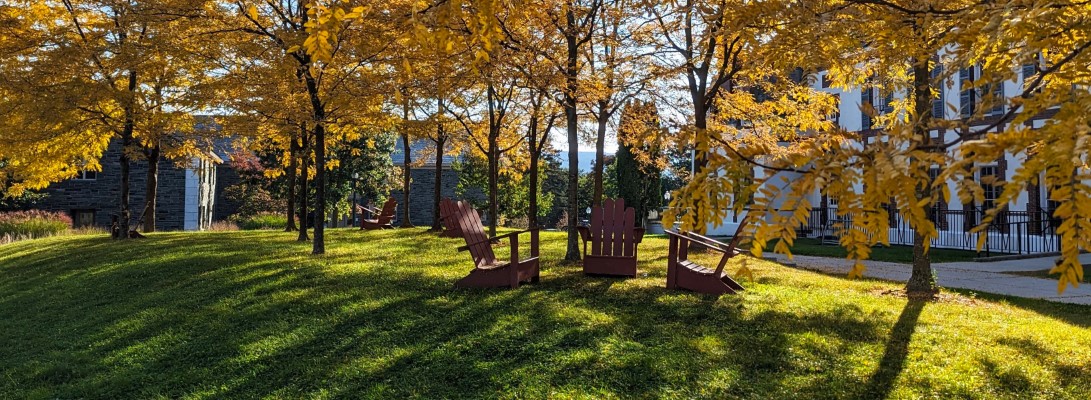As part of our Tree Campus Higher Education Certification, we’re asked as an institution to summarize our year and activities managing our urban forest. 2023 has been, frankly, a year.
Our numbers for tree removals and plantings might seem a little off this past year, and are. The story is one echoed throughout the state, one of extreme weather events. I’d estimate in my 18 years here I’ve responded to 10-12 extreme storm events impacting our urban forest-ice, rain, wind, heavy snow, and the ilk. Of those 10 or so, 4 of them were last year, or more accurately in our reporting year, which starts roughly mid-December, when the information is due. Fortunately, we have a beautiful campus with a mostly healthy tree population, so while we lost some trees, we’re not panicking yet.
We have about 2400 trees on our grounds we maintain as individuals, that is the group I call our urban forest, and what we report on for our Tree Campus certification. We lost many trees this year in the woods and fencelines surrounding campus, but forest management is different than grounds management, so we don’t count those.
All said over 2023 we removed 80 trees, more than half of those lost to storm damage. Some were removed for preemptive Emerald Ash Borer work, and a couple were removed from underlying health issues. We planted 70 trees, so our Tree Karma score is a little off. Tree planting, however, is a multi-year process, in that they need care for a couple of years beyond the initial planting. We’re at about the limit of our resources to plant that many trees at once in disparate locations, so we’ll keep planting more over the next couple of years to rebalance this dreadful removal year.
The year started December 16-17, 2022, with a simple 1″ snow. Warmth in the mid to upper 30’s made this arboreally challenging. The snow was clumpy, heavy, and wet, picture ideal snowman snow. It clung to branches and limbs, and the weight broke many of them. We had sticks scattered across campus, and many dangerous branches stuck up in the upper canopies of many of our trees. This is an immediate hazard, known to loggers in the woods as widow makers, apt to fall unpredictably. As we were pruning, climbing, and assessing these shattered trees, later that week campus got hit again.
And this storm was much more serious. Our weather station at Dragone Track recorded a peak gust of 63 mph, which ordinarily would be ok. Not great, but ok. A second factor was at play here.
Trees grow and adapt based on stress, and even a strong wind from a normal direction should be absorbed by the tree structure fine. Winds from this storm, however, came from the East. This is exceedingly rare in the Champlain Valley, and always portends trouble. Easily half of our removals for the year came from this storm.
We had a pretty nice, albeit dry spring. I was actually getting nervous in the lack of precipitation, not looking forward to what could have been a third consecutive drought year. Our weather station was down for many of the storms this summer (since repaired), but another local site recorded only 2.15″ pf rain in April, and 1.89″ in May. And then…
5.13″ in June. 12.53″ in July. 11.65″ in August. Only (only) 3.21″ in September, just in time to dry out for October, which clocked in at 7″. We had a thunderstorm July 13 with a peak gust of 61 mph (from the south, less damage), and flooding in all of Middlebury and the immediate surrounding community on August 3rd, resulting in 5.65″ of rain. To say we’ve never seen anything like it sounds like the cliché it is. Better words are lacking.
Aside from flooding, the main stress to trees with this much rain is saturated soil. Plants need water to live, but as important is air. When the soil is super-saturated, unable to absorb more water, it means the soil is completely full of water, and there is no air left in the soil for the roots to respire. I’d seen trees this summer in full wilt, ordinarily a symptom of too little water, but in this case too much, as the symptoms are the same for both conditions.
We did find the time for some new planting projects. Allen Hall got a septic line replacement, and we re-landscaped the entrance for that. The Davis Family Library has a bed in front that had a couple of shrubs die, we replaced and expanded the bed.
We also did a small planting and some trees around a memorial bench for Will Nash ’20.
Lastly, this was the kick off of Rewilding Middlebury, with extensive work down in the Library Quad. The library quad was chosen to trial all of our We did an extensive renovation of existing lawn, turning it into a Native Fescue Zone.
Another large section right next to the library was converted to Dwarf White Clover, and lawnmowing in that area was cut drastically, yet still kept low and green, preserving the open (and mouse free) area next to the building.
A large block of trees was also planted near this area, all in native trees. Vermont wants to be forested, so we’re helping it along a little bit.
The front of The Axinn Center at Starr Library saw a small (for us, 5000 square feet) area planted to native pollinator wildflowers, and should be blooming next year.
Oh, and if this year couldn’t get any stranger, we had to chase a moose away from the golf course.











